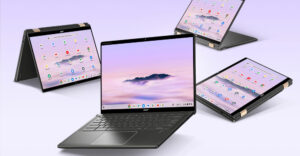
Notebook computers are all the rage, and an ever-expanding emphasis on mobility is forcing both consumers and business executives to purchase these devices.
“2007 was a very good year for notebooks: Sales were up 20 percent,” said Roger L. Kay, president of market intelligence firm Endpoint Technologies Associates.
The high growth factor has attracted a variety of vendors who have been trying to position their products as a customer’s best option. Consequently, they are delivering devices with new features, such as smaller form factors, integrated support for multimedia functions and more disk storage. As these functions take hold, users find themselves with a growing array of possible purchasing options.
Convenience has long been a hallmark with these mobile systems, and that is forcing suppliers to deliver smaller devices. “When they are traveling, business professionals want to carry as little as possible without sacrificing functionality, and some of the new laptops enable them to do that,” Richard Shim, a research manager at market research firm IDC, told TechNewsWorld.
Moving Down to a Foot
Vendors have focused on building these tinier laptops because they command premium prices. However, it can be a challenging engineering task to extend the device’s battery life and cram sufficient performance into the smaller form factors. The low water mark had been 13-inch screen sizes, but recently 12-inch models have become more popular. These devices measure a foot in length, nine to 10 inches in width, and around an inch deep. They weigh as little as a single pound. Then there’s the headline-grabbing MacBook Air, which features a 13.3-inch screen, weighs 3 pounds, and is just three quarters of an inch deep.
Though they possess minute form factors, many of the devices support robust functionality. Sony sells 12-inch notebooks, dubbed the “VAIO G series.” To lower the weight, the company used carbon material for the casing. The device features an Intel Core Solo U1300 with 1.06 GHz (gigahertz) CPU (central processing unit), 512 MB RAM (megabytes of random access memory), 80 GB (gigabytes) HDD (hard disk drive), DVD multi-drive, WLAN (wireless local area network), fingerprint sensor, Bluetooth connectivity, and a battery pack that extends battery life up to 12.5 hours.
Additional functionalities, such as touchscreens, are making their way to the miniature devices. Asian manufacturers, such as AU Optronics and Chunghwa Picture Tubes, have reportedly been developing a 12-inch display that would use in-cell touch input, escaping the need for a separate layer just to sense contact from the user. The technique allows for delivery of displays that are as thick as today’s LCDs (liquid crystal display) and contrasts sharply with many tablet PCs, which often add bulk to deliver touch capabilities. Initially, the notebook touchscreens are expected to be limited to support for a single input option, but eventually multi-touch interfaces will become available.
The Video Imprint Spreads
The widespread adoption of Internet video has meant that laptops are displaying more movie content, and that trend has impacted the devices in several ways. Increasingly, the portable systems are being equipped with high-definition multimedia interface (HDMI) ports that let users view their content in its full resolution on HDTVs. With the emerging interface, users can rely on one cable to deliver high-definition video and multi-channel, digital audio to digital display devices, such as digital TVs, plasma displays, LCD TVs and projectors.
Video, especially HD applications, means larger files, which lead to bigger storage requirements. The emergence of gaming notebooks from vendors such as Alienware and VoodooPC (which HP acquired), underscores this trend. “The gaming notebook segment is small but growing and lucrative because these systems require top-of-the-line features,” Leslie Fiering, research vice president at Gartner, told TechNewsWorld.
Alienware included single and dual Samsung 320 GB hard drive configurations in RAID 0 and RAID 1 in its Area-51 m9750 and Aurora m9700 notebooks. The Area-51 m9750 and Aurora m9700 provide up to 640 GB of hard drive space, which means users can store up to 107 games (6 GB per game) or 160 movies (4 GB per movie).
SSD Storage Gains Traction
Another trend in notebook storage is the use of Solid State Disk (SSD) storage. “SSD contains no moving parts — which are prone to mechanical failure — and operates more quickly than traditional hard drives due to its lack of spool-up time,” Endpoint’s Kay told TechNewsWorld. An SSD drive reads data at speeds up to 62 Mbps (megabits per second) — nearly 100 times faster than hard drives typically found in notebooks. This capability has made its way into select models: Alienware’s Area-51 m9750 offers a 64 GB SSD in addition to a 320 GB hard drive.
There are a few gotchas with this option. Since these devices are new, they may possess a few more flaws than hard disk drives. Also at the moment, this option is expensive, adding a few hundred dollars to a notebook’s list price. Pricing is expected to drop as the number of laptops with this feature rises.
In addition to being more powerful, the portable devices are following the lead of cell phone vendors and becoming fashion statements. As the year closed, Micro-Star International announced its PR200 YA Edition line, which is available in Denim Blue, Coral Pink and Wasabi Green. Dell is another vendor selling notebooks — including its 15.4-Inch Inspiron notebooks — in multiple bright hues. Because the market is growing at a rapid rate, other vendors are expected to take similar steps to differentiate their products in the coming months.




















































